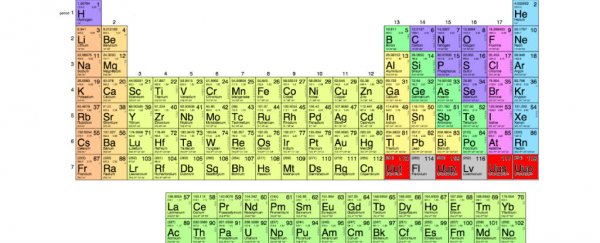Back in January, officials announced that four new elements had earned a permanent spot on the periodic table, with elements 113, 115, 117, and 118 rounding out the seventh row.
At the time, they all had temporary names and symbols - ununtrium (Uut), ununpentium (Uup), ununseptium (Uus), and ununoctium (Uuo) - but the tyranny of the Uus is finally over, because we now have some shiny new names to get excited about.
Teams of researchers from the US, Russia, and Japan have all been credited with the discovery of these new elements, so have been given the naming rights - which come with some very specific criteria.
As stipulated by the International Union of Pure and Applied Chemistry (IUPAC), the organisation responsible for confirming the discovery of new elements, any new element must be named after either:
- A mythological concept or character (including an astronomical object)
- A mineral, or similar substance
- A place or geographical region
- A property of the element
- A scientist
Nice to see that fantasy nerds can still get their fill. Can we please call something drogonian?
With that in mind, here are the new proposed names:
- nihonium and symbol Nh, for the element with Z =113,
- moscovium with the symbol Mc, for the element with Z = 115,
- tennessine with the symbol Ts, for the element with Z = 117, and
- oganesson with the symbol Og, for the element with Z = 118.
As Brian Resnick reports for Vox, nihonium is derived from "Nippon", a Japanese word for Japan, and moscovium honours the Russian capital city, Moscow.
Tennessine is named after the state of Tennessee, known for its pioneering research in chemistry. "Tennessine is in recognition of the contribution of the Tennessee region, including Oak Ridge National Laboratory, Vanderbilt University, and the University of Tennessee at Knoxville, to superheavy element research," says the IUPAC.
This marks the second US state to be honoured on the periodic table, the first was California, referenced by californium (element 98), which was discovered in the 1950s. Hassium (element 108), was named after the German state of Hesse.
Oganesson is named after 83-year-old Russian physicist Yuri Oganessian, and according to Richard Van Noorden from Nature, this is only the second time a new element has been named for a living scientist.
"The first such occasion led to huge controversy, when in 1993 a team at the Lawrence Berkeley National Laboratory proposed naming element 106 seaborgium for US nuclear-chemistry pioneer Glenn Seaborg," says Van Noorden. "At the time an IUPAC committee rejected the proposal, after passing a resolution that elements not be named for living scientists, but it ultimately relented."
The names were proposed by the research teams, accepted by the IUPAC, and now have to undergo a five-month period of public review, which expires on 8 November 2016.
If no one complains - which is likely, considering how inoffensive they all are - the names will then get formal approval. Then it's time to throw out our old text books and scrub down our bathroom walls and make room for the new arrivals.
So why did these four elements take so long to make it on to the periodic table?
Unlike the classics, such as gold, iron, and aluminium, these new elements are not found in nature. They're synthetic elements that can only be created in the lab, and they decay so fast after synthesis, for years the teams behind them didn't have a chance to get a proper look before they morphed into something else entirely.
"For over seven years we continued to search for data conclusively identifying element 113, but we just never saw another event," Kosuke Morita from RIKEN in Japan said of nihonium back in January. "I was not prepared to give up, however, as I believed that one day, if we persevered, luck would fall upon us again."
The Japanese team now has its sights set on "uncharted territory of element 119 and beyond", so hopefully we'll have a drogonian element soon. (We all need to dream sometimes!)
